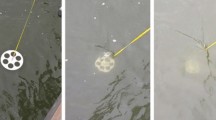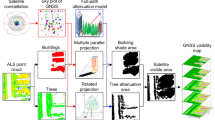Abstract
Long-distance measurement of lidar is a critical problem in various fields, such as airborne lidar detection, surveying, and mapping. Attenuation characteristic is the key factor affecting the lidar detection capability. However, some long-distance measurement methods based on the widely used and validated theoretical models are usually inefficient, while others relying on empirical models have limited applications due to experimental difficulties. This study proposes a semi-empirical model of long-distance measurement based on the Beer–Lambert–Bouguer law adopting mathematical methods. Compared to the theoretical model, the calculation efficiency of the semi-empirical model we constructed has been improved by more than two orders of magnitude, and the accuracy can reach more than 98% of the theoretical model. Compared to other empirical models, its accuracy is closer to the theoretical model, and the computational efficiency is similar. It can be more effectively applied to the actual long-distance detection scene.






Similar content being viewed by others
References
T. Fahey, M. Islam, A. Gardi, R. Sabatini, Atmosphere 12, 7 (2021)
V.A. Kovale, W.E. Eichinger, ELASTIC LIDIR Theory, Practice, and Analysis Methods (Wiley, New Jersey, 2004)
F.C. Bohren, D.R. Huffman, Absorption and Scattering of Light by Small Particles (Wiley, New York, 1983)
K. Ahn, S.-H. Lee, L.-K. Park, H.-S. Yang, J. Korean Phys. Soc., 79(2021).
H. Moosmuller, R.K. Chakrabarty, W.R. Arnott, J. Quant. Spectrosc. Radiativ. Transfer 110, 844–878 (2009)
I.E. Gordon, L.S. Rothman, C. Hill, R.V. Kochanov, Y. Tan, P.F. Bernath, M. Bork et al., J. Quant. Spectrosc. Radiat. Transfer 203, 67 (2017)
H. Cui, University of Chinese Academy of Science, (2019)
L. Rayleigh, Philosophical Magazine 41 (1970)
L. Rayleigh, Philos. Mag. 41(1958)
G. Mie, Annalen der Physic 25, 3 (1908)
H.C. Van de Hulst, Twersky, Light Scattering by Small Particles (Wiley, New York, 1957)
C.E. Junge, Air Chemistry and Radioactivity (Academic Press, New York, 1963)
D. Deirmendjian, Electromagnetic Scattering on Spherical Poly-dispersion (American Elsevier, New York, 1969)
E.J. McCarney, Optics of Atmosphere: Scattering by Molecules and Particles (Wiley, New York, 1977)
K.I.M. Sangbum, K.I.M. Kihong, J. Korean Phys. Soc. 64, 8 (2014)
W.G. Alheadary, K.-H. Park, N. Alfaraj, Y. Guom, E. Stegenburgs, T.K. Ng, B.S. Oi, M.-S. Alouini, Opt. Express 26(6), 6614 (2018)
I. I. Kim, B. McArthur, E. Korevaar, In Optical Wireless Communications III, E. J. Korevar, ed., Proc. SPIE, vol. 2001(2001)
H. Vasseur, C.J. Gibbins, Radio Sci. 31, 1089–1097 (1996)
P.W. Kruse, L.D. McQuistan, B. Richmond, Elements of Infrared Technology: Generation, Transmission, and Detection (Wiley, New York, 1962)
D. K. Kreid, Appl. Opt. 15(1974)
M. Ljaz, Z. Ghassemlooy, J. Pesek, O. Fiser, H.L. Minnh, E. Bentley, J. Lightwave Technol. 31(11), 1720–1726 (2013)
P. Qiu, G. Cui, Z. Qian, S. Zhu, X. Shan, Z. Zhao, X. Cui, P. Tian, Opt. Express 9(2021)
M. Grabner, V. Kvicera, Opt. Express 19, 4 (2011)
P. Lin, T. Wang, W. Ma, Q. Yang, Z. Liu, Opt. Express 28, 26 (2020)
Y. Li, M. Li, R. Duan, Z. Liu, T. Wang, W. Ma, Z. Tao, Y. Lou, H. Jiang, Appl. Opt. 61, 8 (2022)
F. Nadeem, E. Leitgeb, M.S. Awan, Netw. Digit. Signal Process. (2008).
P. Chylek, J. Atmos. Sci. 35, 2 (1978)
R. Nebuloni, Appl. Opt. 44, 18 (2005)
M. Damico, A. Leva, B. Micheli, IEEE Microwav. Wirel. Compon. Lett. 13(8), 305–307 (2003)
S. Yu, M.S. Chen, L. Song, Guangxi Commun. Technol. 1(2008).
Y. Dai, The Principle of Lidar in Chinese (National Defense Industry, Beijing, 2002)
R.G. Eldridge, Bull. Am. Meteorol. Soc. 50, 422–427 (1969)
R. Wang, Xian China: Xi'an Univ. Electron. Sci. Technology, (2007)
D. Li, H. Chen, Electron. Des. Eng. 19, 9 (2011)
Acknowledgements
The authors thank Yikun Liu, Bobing Ye for helpful discussion and comment. This work has been funded by the Shenzhen Science and Technology Program Grant No. KQTD20190929172704911. We would like to thank Editage (www.editage.cn) for English language editing.
Author information
Authors and Affiliations
Corresponding author
Additional information
Publisher's Note
Springer Nature remains neutral with regard to jurisdictional claims in published maps and institutional affiliations.
Appendix A
Appendix A
1.1 Theoretical calculation of absorption and scattering coefficients
where \(C_{abs}\) and \(C_{sca}\) are absorption and scattering cross-section; \(r\) is radius; \(F(r)\) defines aerosol size distribution;
For simplicity, extinction cross-section (\(C_{{{\text{ext}}}}\)) and aerosol effect coefficient (\(\eta_{n} \left( h \right)\)) are described as the sum of \(C_{{{\text{abs}}}}\) and \(C_{{{\text{sca}}}}\), \(k_{n} \left( h \right)\) and \(\beta_{{\text{n}}} \left( h \right)\), respectively.
Absorption and scattering cross-section can be further calculated as follows:
which are related to the wave number \((l = 2\pi /\lambda )\), scattering coefficients (\(a_{k}\) and \(b_{k}\)) analyzed by Eqs. 35–36, size parameter (\(x = lr\)), spherical Bessel functions (\(j_{k}\) and \(h_{k}^{(1)}\)), refractive index (\(iR\)), permeability (\(\mu\)) of sphere, and permeability (\(\mu_{1}\)) of surrounding the medium function of rate.
Rights and permissions
Springer Nature or its licensor holds exclusive rights to this article under a publishing agreement with the author(s) or other rightsholder(s); author self-archiving of the accepted manuscript version of this article is solely governed by the terms of such publishing agreement and applicable law.
About this article
Cite this article
Tan, Z., Zhang, Y., Yang, Y. et al. Numerical semi-empirical modeling of lidar attenuation characteristics in atmosphere. J. Korean Phys. Soc. 81, 1231–1239 (2022). https://doi.org/10.1007/s40042-022-00635-3
Received:
Revised:
Accepted:
Published:
Issue Date:
DOI: https://doi.org/10.1007/s40042-022-00635-3




